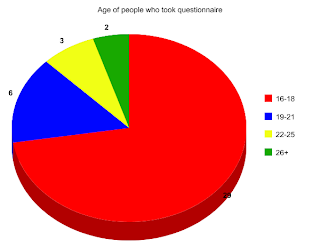A common convention of trailers in general, but more specifically horror trailers, is to have inter titles that continue throughout the trailer, eventually forming a complete sentence, these help build suspense and leave the audience wondering what’s coming next, my inter title reads, "...abuses your faith...", this shows that it's only part of a sentence. There is usually an effect on the writing to make it more interesting, as you can see in the stills both our trailer and the real trailer have a glowing effect on a black background, creating the sense of delusion and some that is not normal.

In the genre of horror a common concept is that the 'monster' is something of darkness, something of evil that holds connotations of death. This is often shown through the use of a silhouette, as seen in these stills,or by having the shadow of something evil reflected on a light wall. These stills also show use of the extreme low angle shot, this gives the audience the impression that the monster has power over them, and that they are smaller and weaker than they are, this adds to the horror of the frame. Expressive camera work is a big part of horror. It worked very well in my trailer, because it gave an creepy feel to the monster and making him seem something of darkness that is not from our world, and is nothing but pure evil.

In horror films extreme close ups are used a lot, the idea behind this is that the invasion of our personal space, and leaves the audience with the feeling that there is no escape from the monster. These stills are used to scare the audience, it gives a feeling of helplessness, but at the same time it can allow us to sometimes sympathise or even understand the monster, this is most effective when the monster is the was he/she is because of a traumatic past. In our trailer it makes puts the audience in the place of Emily, because they can full on see what she's running from, this intensifies the evil presence of the monster and add's an extra dimension of fear for my audience.

The rating for my horror film is an 18 certificate, this is because it includes elements of gore, films such as 'Saw' and 'Hostel' also have gore in. This is popular among my target audience, and will help make my film a success. These stills show the scene's of gore that are in my trailer and a real trailer, I had to have some gore in the trailer to attract my target audience. This falls under the genre of gore-nography, which is sometimes known as torture porn.
These stills inherit the same ideology, which is that the audience are being drawn into the darkness, connoting that all hope is gone, it gives them a taste of the world of the monster, reinforcing it's evil.The light represents the only happy place in the frame, holding connotations of heaven and peace. This puts the image of isolation and hell into the audiences mind, and that there is no escape from the dark horrific place they are being taken into.

This shot makes use of a staircase, it's a conventional setting in horror, and something that is iconic in the genre. The idea of it is that the staircase takes you down into a dark hellish place, with no escape. The whole idea of a basement is scary to are target audience, it holds connotations of our primitive instincts. This shot is very effective and has been used in many genres of horror for a long time, this is because it's so effective and has a scary ideology. It's usually used to lead down to the torture room of the monster, and we used the shot for that exact purpose, and down here is where he "corrects there sins".

Having an extreme close up of my 'final girl' is a popular technique, it allows us to identify with the terror of the victim and brings us into her world. Another thing this shot does is to exclude all threat from the frame, this makes it scarier for the audience, as they don't no where the monster will be coming from. This is something that the audience of my movie will want to see, they enjoy the thrill of not knowing where the evil is coming from, and being able to see things from the point of view of the victim. Shots like this will make the trailer more of a success because it will make my audience want to see more of it, as it's something that they like to see in this genre.

A lot of horror films have scenes that take place in a forest, and my trailer takes place in this stereotypical setting. This still is from "Eden Lake", and shows the main protagonist running through the forest away from the monster, in my trailer we have used this same exact theme, it works with my target audience. This conventional horror setting works in my trailer, as it certifies the genre of it, it also helps to attract the right target audience, as it is appealing for them to see a 'final girl' of similar age, running through the woods, away from someone of complete evil.










































